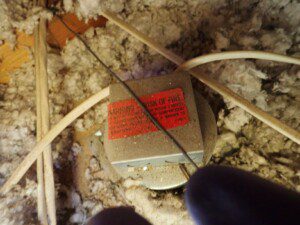
Fixtures that are not rated for insulation contact have a single walled canister, which can grow quite hot from the heat of the bulb. This heat is designed to dissipate into the empty space that the recessed fixture is installed within. If insulation covers the canister, it can cause the fixture to overheat and potentially start a fire. If combustible insulation is in contact with the canister, it can heat up and ignite. Modern fixtures have a heat-sensitive internal switch that can shut off the circuit if the fixture overheats.
What makes a light fixture safe for insulation contact is a two-walled design. While the inner canister can grow hot, the heat dissipates in the chamber formed by the outer canister wall. This outer wall should remain cool enough to be in contact with and covered by insulation.

Keeping insulation away from recessed lighting with shrouds poses another problem: heating or cooling loss. Uninsulated area in the attic around a light fixture will allow heat transfer between the conditioned living space and the attic. Not only does this reduce the energy efficiency of the home, heat in unconditioned attic space increases the chances of mold growth. Warm air holds more moisture than cold air, so if attic air is heated from uninsulated ceilings, the air tends to become more humid. When humid air meets the cold lower surface of roof sheathing, it may condense on this surface. Since mold spores are everywhere in the air and filter into attics through ventilation openings, moist surfaces foster spores germinating and fungal hyphae growth.
A better solution is to fully insulate ceilings below attic spaces. IC-rated light fixtures are designed for this application as long as bulb are kept within the designated rating. In new construction, builders should ensure that IC-rated fixtures are installed wherever ceilings will be insulated. However, older homes typically had less insulation, so remodels may be equipped with non-IC-rated fixtures. Additional insulation may have been installed later, in some case covering the vulnerable fixtures.


If installing recessed lighting, a homeowner should select canisters that are rated for the insulation conditions of the space, and trim that allows the desired types and wattages of bulbs. Another consideration for new installation is whether the fixture is rated AT or air-tight. Air-tight fixtures are designed to eliminate air movement from conditioned indoor space to uninsulated spaces, typically attics. This can result in large savings in heating and cooling energy, as a small opening allowing air movement can transfer as much heat as many times that area that merely lacks insulation. Air-tight fixtures also help prevent attic air, which typically contains insulation fibers, dust and perhaps mold spores, from entering the living space.
In homes that have existing recessed lighting, homeowners should inform themselves on the IC status of the fixtures. As noted, removing the bulb may reveal labels with that information. Information not on the fixture may be found online if the manufacturer and model number are present. It is wise to inspect several fixtures, especially if they are in different rooms or look different. A home may have a mix of IC-rated and non-IC rated fixtures. It is also important to determine the bulb type and wattage rating and compare that with the fixture chart if present. Keeping in mind that bulbs wear out and are typically replaced at different times, a scan of all bulbs for excessive wattage is recommended.
If non-IC-rated fixtures are present, with insulation covering them, they could be replaced with IC fixtures to avoid removing insulation. Alternately, as a less-expensive step, they could be replaced with LED bulbs. LED bulbs have much lower wattages than incandescent bulbs for comparable light outputs and generate much less heat. They also have much longer lifespans, which can offset the investment. Following manufacturer recommendations is always the safe approach.
Recessed lighting can be a great feature in a home, and the fire risk of inappropriate fixtures makes investigating them vital. If adding recessed fixtures, research can help you direct your investment in safe ways that meet your needs. If purchasing a home with existing fixtures, inspecting them can alert you to safety concerns and potential repair needs. We hope this article can help you follow up on a thorough home inspection with your own observations.


